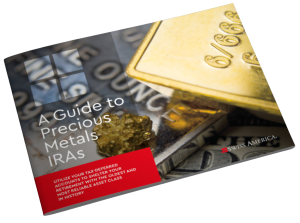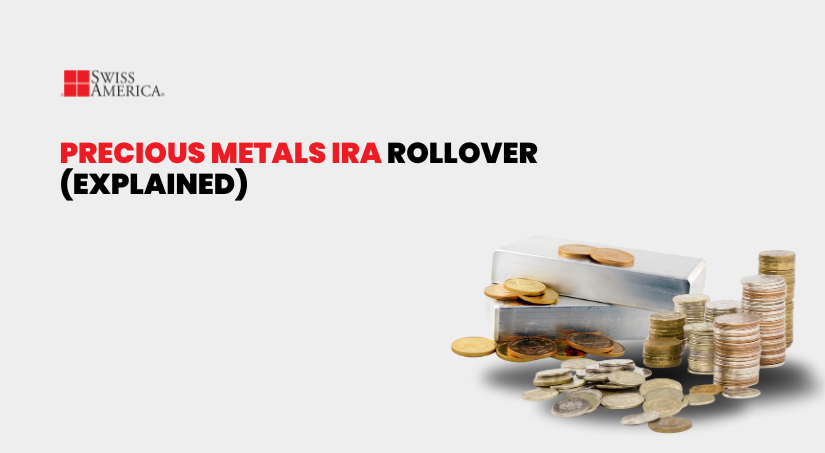
People are worried about the current economic environment, and they’re looking for protection and stability. That’s why a precious metals IRA rollover might make sense right now. Many investors turn to gold and other metals as a hedge against stock market volatility and broader financial uncertainty.
Gold has been in a bull market for years, and there’s no sign that momentum is slowing. J.P. Morgan Chase recently projected that gold could reach $4,000 an ounce by the second quarter of 2026. So, if you’ve been thinking about getting started with gold, silver, or even platinum, a precious metals IRA rollover could be a smart way to take that step.
Learn how the rollover process works, what you can buy in your IRA, and the IRS rules you need to follow.
What is a precious metals IRA?
A precious metals individual retirement account (IRA) is a self-directed account that lets you put your funds into alternative investments. You can hold metals like gold and silver as part of your long-term savings. You might also hear it referred to as a Gold IRA or silver IRA.
The rollover is the part where you move funds from an existing retirement account or investment portfolio into your precious metals IRA. Note that you don’t have to transfer the entire amount. Most advisors recommend holding around 10% to 15% of your portfolio in physical precious metals as part of a balanced strategy.
Benefits of a precious metals IRA
Gold acts as a safe haven during times of geopolitical tension and global instability. When you add gold coins, bars, and other approved metals to your self-directed IRA, you can take advantage of benefits like:
Portfolio diversification
You’ve probably heard the saying, “Don’t put all your eggs in one basket.” For investors, that means not relying on a single type of asset. Markets move, and when they do, having everything in one place can backfire.
That’s where owning precious metals can be a good strategy. Gold and silver can hold their value through inflation, downturns, and financial crises. They’re not tied to earnings reports, interest rates, or central bank decisions the way stocks and bonds are. They move on their own terms.
When you add metals to your portfolio through a Gold IRA rollover, you’re creating balance. It helps you spread risk across different types of assets. Stocks and bonds tend to react to the same market pressure. Metals don’t. That separation is what makes them useful in a long-term strategy.
Tangible assets
A big reason people buy precious metals is that they want something tangible. It’s the same idea as owning real estate. You’re not just looking at numbers on a screen because you own something physical. It’s yours.
That’s different from paper assets like index funds, ETFs, or bonds. With those, you’re relying on someone else to follow through. A company needs to perform. A fund manager needs to handle things correctly. A government or institution needs to keep its promise. That’s called counterparty risk. And when things go sideways, that risk becomes real.
Take the 2008 financial crisis, for example. Many people held mortgage-backed securities or other “safe” investments they didn’t fully understand. When the system failed, they found out the hard way how exposed they were. Values dropped, and people lost money. Meanwhile, gold prices during the recession rose over 100% from 2008 to 2012.
With precious metals, you’re not depending on someone else to keep a promise. You hold the asset directly. It has weight. It’s in your name. That kind of ownership offers a different kind of peace of mind, especially when markets get shaky.
Inflation hedge
One of the biggest reasons people turn to gold and other metals is to protect against inflation. The idea is simple. You buy gold using today’s dollars, and because it’s a physical asset, it holds value in a way paper assets may not. As inflation rises, the price of gold tends to rise too. That increase helps preserve the value of your original investment.
We’ve seen this happen time and time again. You could look decades back, but the last five years alone tell the story. Between 2020 and 2025, cumulative inflation has been 21.7%. Something that cost $1.00 in 2020 now costs $1.22.
Gold during that same period went from $1,729 an ounce in June 2020 to around $3,343 an ounce today. That’s a 93% increase. While inflation chipped away at the dollar’s buying power, gold did more than keep up. It grew far beyond the rate of inflation, which is exactly the kind of protection long-term investors are looking for.
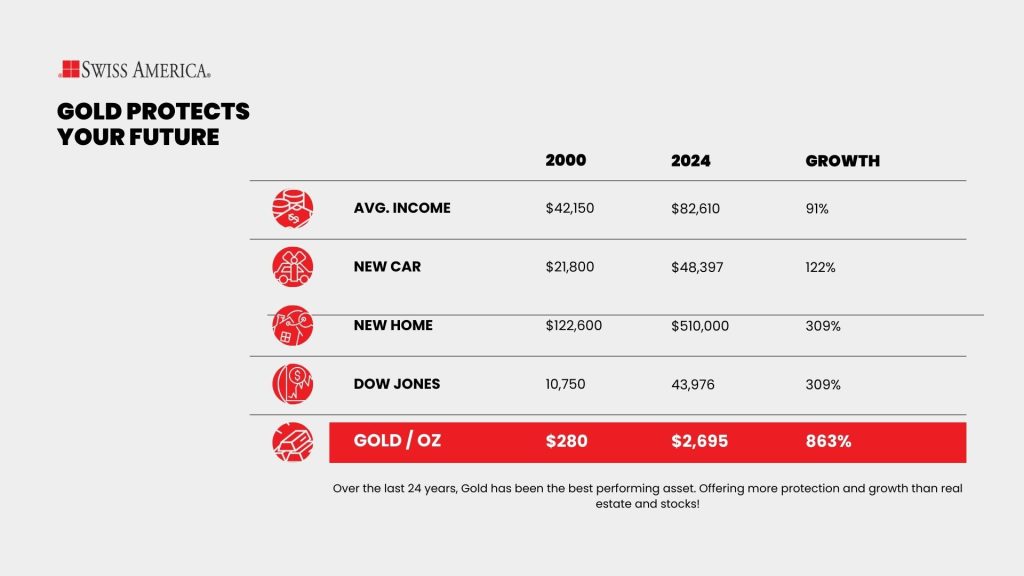
Drawbacks of a precious metals IRA
We always want to give a full picture of what to expect if you’re thinking about investing in precious metals, whether that’s coins or bars. Here are a few drawbacks to keep in mind as you weigh your options:
No income
Gold doesn’t pay dividends or generate income. That’s not why people invest in it. The real purpose is wealth protection. It’s a defensive strategy, similar to buying insurance. You may see a return over time, but that’s not the core reason to own it.
As long as you understand this going in and take the time to decide what portion of your portfolio you want to hold in precious metals, you’ll know what to expect.
Storage and fees
All investments come with fees. With gold, one of the main things to understand is that you’ll pay a premium over the spot price. If you search for gold prices online, you will see the spot price, which is the base market value. But, like any retail product, there’s a markup.
It works the same way as buying anything at a store. The grocery store pays a wholesale price and then charges a little more when it sells it to you. Gold dealers do the same. So, when you’re researching or thinking about buying gold, know that the price you see online won’t be the final amount you pay. When you work with a dealer like Swiss America, our fees are transparent, so you’ll know what the costs are upfront.
Now, here’s the part that people aren’t sure of, which is storage. If you’re buying gold, silver, or platinum for a precious metals IRA, you can’t store it at home. The IRS requires that you keep your metals at an approved third-party depository. This is because if you try to store the metals yourself, the IRS sees that as a distribution, which can trigger penalties and taxes.
Because of this rule, you’ll have storage costs. However, it’s not a huge expense. The exact amount depends on which custodian you work with, but in many cases, basic storage is around $100 a year.
Liquidity
Because gold is a tangible asset, it’s not as quick to sell as paper assets like mutual funds. With those, you can sell with a few clicks to complete the sale. Physical assets take a little more time. It’s the same idea as real estate. There’s an extra step involved.
But here’s the good news. Selling gold isn’t like listing a house and waiting around for a buyer. In most cases, you can sell your gold back to the same dealer you bought it from. The process is simple and usually much faster than people expect. It’s not instant, but it’s not complicated either.
Gold IRA rollover rules
There are different types of gold IRA rollovers available to investors. But two main and common types include:
Direct rollover
In a direct rollover, you move retirement savings or funds directly from an existing, eligible retirement account (IRA, TSP, SEP, 401(k), 401(b), etc.) to your gold IRA. It’s a straightforward process that has less risk of IRS penalties than an indirect rollover.
The process is the same whether you have a traditional or Roth IRA. The only caveat to note is that you can only roll over a Roth retirement account to a Roth Gold IRA. You can’t switch account types because of how the IRS treats taxes on each.
You can roll over a portion of your funds or the entire amount. The IRS doesn’t place a limit on how much you can move from a qualified retirement account into a gold IRA.
Indirect rollover
This is also called a 60-day rollover. In this rollover process, the investor or account holder withdraws funds from one retirement account. Then, you deposit these withdrawn retirement savings into the self-directed Gold IRA account. If you do not complete the transfer within the 60-day period, the funds become a taxable withdrawal.
Be aware that this method requires attention to timing so you don’t accidentally trigger a penalty. If you are under 59 ½ years old, the IRS imposes a 10% early withdrawal penalty if you don’t complete it in time. The IRS limits indirect rollovers to one every 12 months.
Eligible retirement account types for a Gold IRA rollover
You can roll over an existing IRA at any time. Employer-sponsored plans usually only allow a rollover once you’ve left that employer. These include:
- 401(k)
- 403(b)
- 457(b)
- TSP
If you’re self-employed and have a SEP IRA, it follows the same rollover rules as a traditional IRA.
Tax differences with Gold IRA accounts
You can use your retirement funds to buy physical gold bullion and other metals through the same two account types you’d find with traditional investments:
Traditional Gold IRA
You fund this account with pretax dollars, and your investments grow tax-deferred. When you reach retirement age at 59 1/2, you can withdraw either the funds or the physical metals, and you’ll pay taxes at your income tax rate at that time.
Most people choose this option when they expect to be in a lower tax bracket in retirement. This account also follows IRS rules for required minimum distributions, which means you’ll need to start taking withdrawals at age 73.
Roth Gold IRA
Roth IRA gets funded with after tax dollars. As long as the account has been open for at least five years, all growth and proceeds are tax-free in retirement. You can take out your original contributions at any time since you’ve already paid taxes and then withdraw the rest after you hit retirement age.
Roth IRAs do not have required minimum distributions.
Types of Gold IRAs
| Feature | Traditional Gold IRA | Roth Gold IRA | SEP Gold IRA |
| Tax treatment | Pre tax contributions taxed withdrawals | After tax contributions; tax-free growth | Pre tax contributions; taxed withdrawals |
| Required minimum distribution | RMDs at age 73 | No RMDs | RMDs at age 73 |
| Best for | Lower tax bracket in retirement | Higher tax bracket in retirement | Self-employed or small business owners |
Gold IRA rollover process
Below is a standard rollover process, from opening the precious metals IRA account to completing your purchase.
1. Choose a Gold IRA company
The first decision you need to make is choosing your Gold IRA company. You want to look for a dealer that has been in business for several years, provides education and training, and can help guide you through the IRA process.
The dealer can also connect you with a IRS-approved custodian, which is the company that will manage your account. Their role is to buy and sell gold per your instructions and ensure IRS compliance.
2. Open your Gold IRA and rollover funds
To set up your account, you’ll sign a custodial agreement and complete your application by providing your personal information. From there, you’ll transfer funds from your existing retirement account to your new self-directed IRA. Your custodian will help you with this by collaborating with your previous account’s custodian.
3. Choose Gold or other precious metals
Your gold dealer can help you choose IRA-approved precious metals. One thing to note is that you can’t buy collectibles or coins that don’t meet IRS standards.
The IRS has these rules in place to make sure you’re buying high-quality metals suited for long-term investment. Approved metals come from government mints or accredited refiners, assayers, or manufacturers. They also need to meet specific purity levels:
- Gold: 99.5% purity
- Silver: 99.9%
- Platinum: 99.95%
- Palladium: 99.95%
4. Purchase and store your metals
Once you know which metals you want to buy, contact your custodian, who will handle the transaction on your behalf.
As mentioned earlier, you can’t store gold, silver, or platinum from your IRA at home. Gold IRA custodians must hold the physical gold in an IRS-approved storage facility until you reach the retirement age of 59 1/2.
These depositories have high-security levels. They use strict protocols and have insurance to cover your metals. Once your custodian completes the purchase, your dealer ships the metals directly to the depository. It usually takes 2 to 4 weeks for a gold IRA rollover to complete.
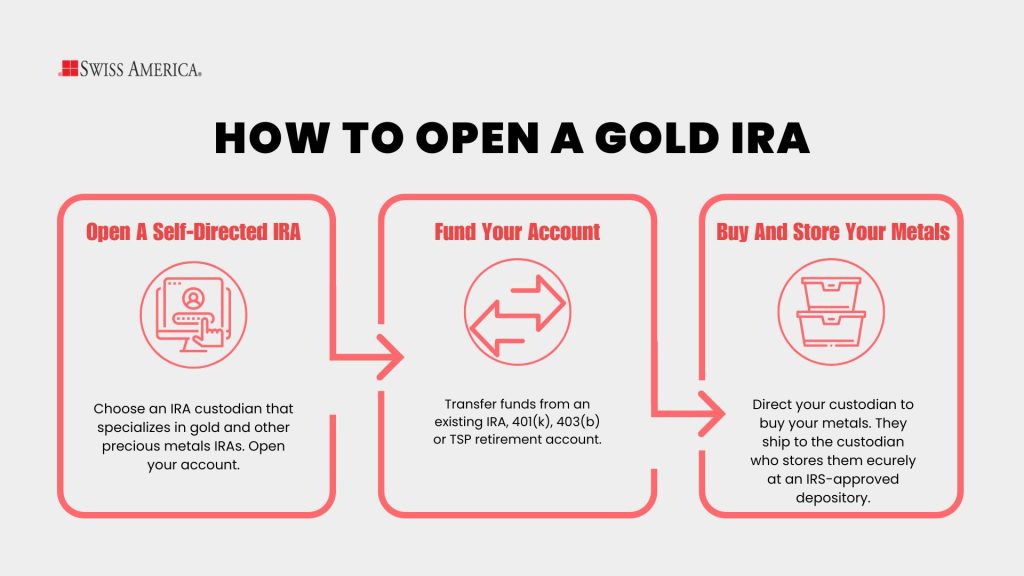
Precious metals investments
The IRS allows you to invest in four main kinds of precious metals for your gold IRA investments. Here are the common coins and bars we usually see people buy:
IRA approved gold coins and bars
This can be gold bullion or proof coins, including American Gold Eagle, American Gold Buffalo, Austrian Philharmonic, British Gold Britannia, Canadian Gold Maple Leaf and more.
IRS approved gold bars include PAMP Suisse, Valcambi, Royal Candian Mint, Credit Suisse, Perth Mint and others.
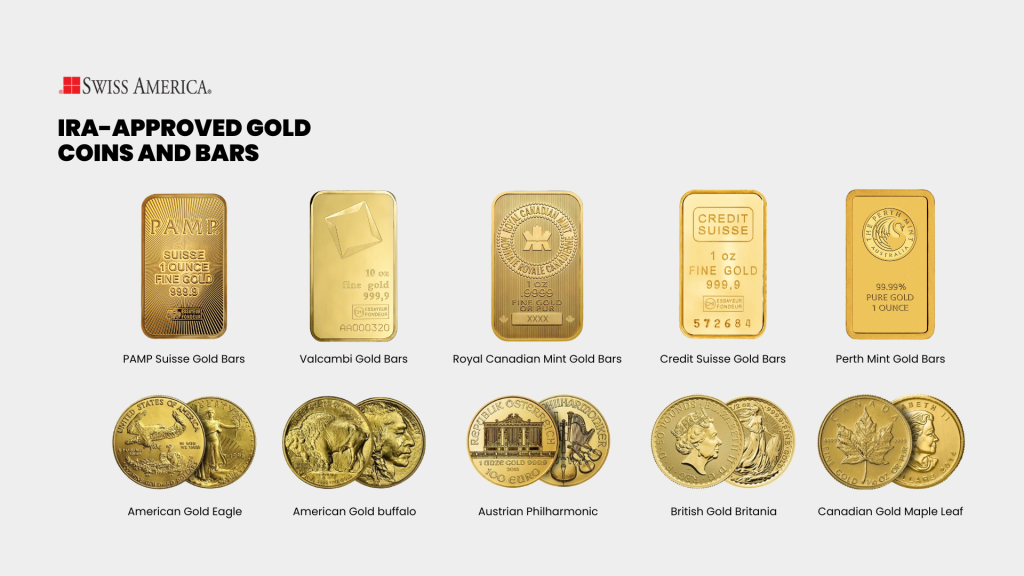
IRA approved silver coins and bars
Examples of approved silver coins include American Silver Eagle, Canadian Silver Maple Leaf, Austrian Silver Philharmonic, Austrialian Silver Kangaroo, Mexican Silver Libertad.
Common eligible bars are Royal Canadian Mint, Perth Mint, PAMP Suisse, Johnson Matthey, Valcambi.
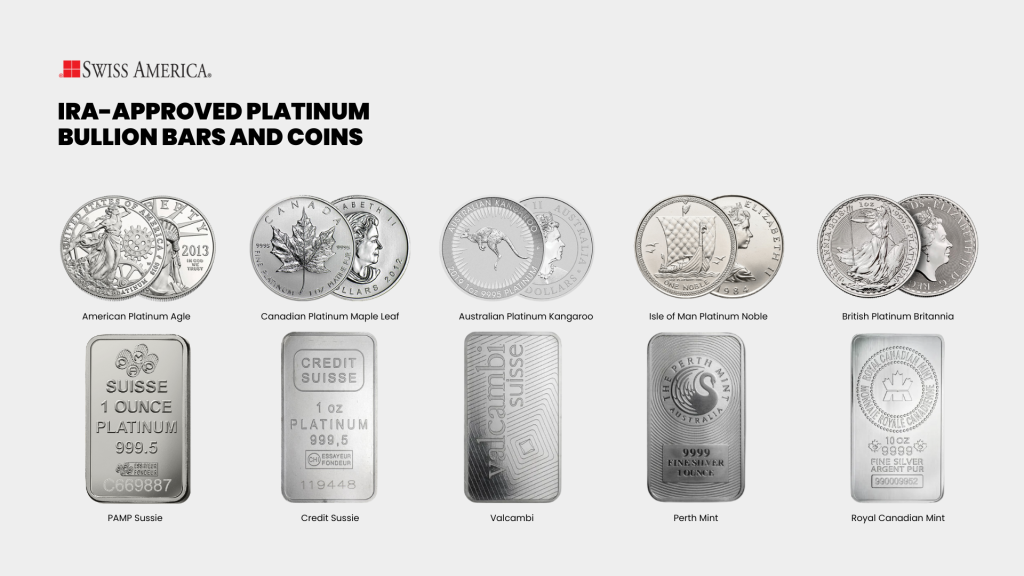
IRA approved platinum coins and bars
The IRS approves platinum precious metal coins like American Platinum Eagle, Canadian Platinum Maple Leaf, Australian Platinum Kangaroo, Isle of Man Platinum Noble, British Platinum Britanna among others.
Bars include PAMPE Suisse, Credit Suisse, Valcambi, Perth Mint and Royal Canadian Mint.
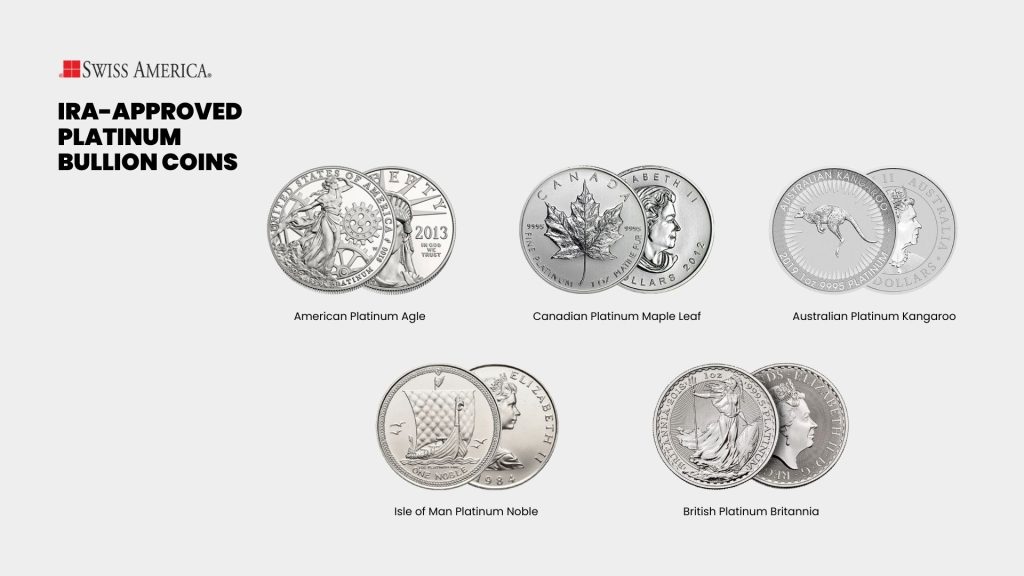
Palladium
You can also buy palladium coins like the American Palladium Eagle and Canadian Palladium Maple Leaf plus bars from PAMP Suisse, Credit Suisse, Johnson Matthey, Valcambi and others.
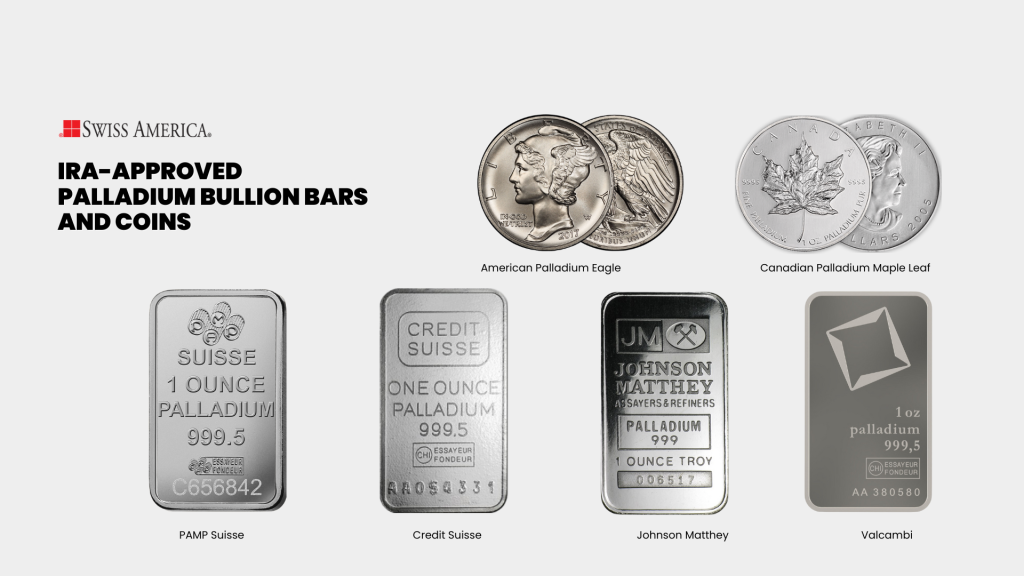
Chosing between bars or coins
Since you can buy either coins or bars you may wonder why choose one over the other what’s the best option how do you decide. Well some of it will come down to how much money you have to invest and then other decision factors just depend on your specific preferences. Here’s some differences to consider:
Bars
Bars are like buying physical gold or other precious metals in bulk. You’ll usually find lower premiums because bars take a more utilitarian approach. They don’t have the intricate designs that coins do, so you’re not paying extra for appearance. And when you buy larger bars, you can cut down on some of the premium costs.
They’re also easier to store. That might not seem like a big deal since you’re not storing them yourself right now, but it could matter later if you decide to take physical possession in retirement.
You can buy the following sizes:
- 1 gram
- 5 grams
- 10 grams
- 100 grams (approx. 3.215 oz)
- 1 ounce (oz)
- 10 ounces (oz)
- 100 ounces (oz)
- 400 ounces (oz)
- 1 kilogram (kg) (1,000 grams, approx. 32.15 oz)

Coins
As we mentioned earlier, IRA-approved coins aren’t the collectible kind, but they do feature beautiful designs. This is what many people imagine when they think about owning physical gold. Coins tend to have higher premiums since you’re buying smaller amounts and part of the cost goes toward the design.
Sizes that are IRA-eligible include:
- 1 ounce
- 1/2 ounce
- 1/4 ounce
- 1/10 ounce
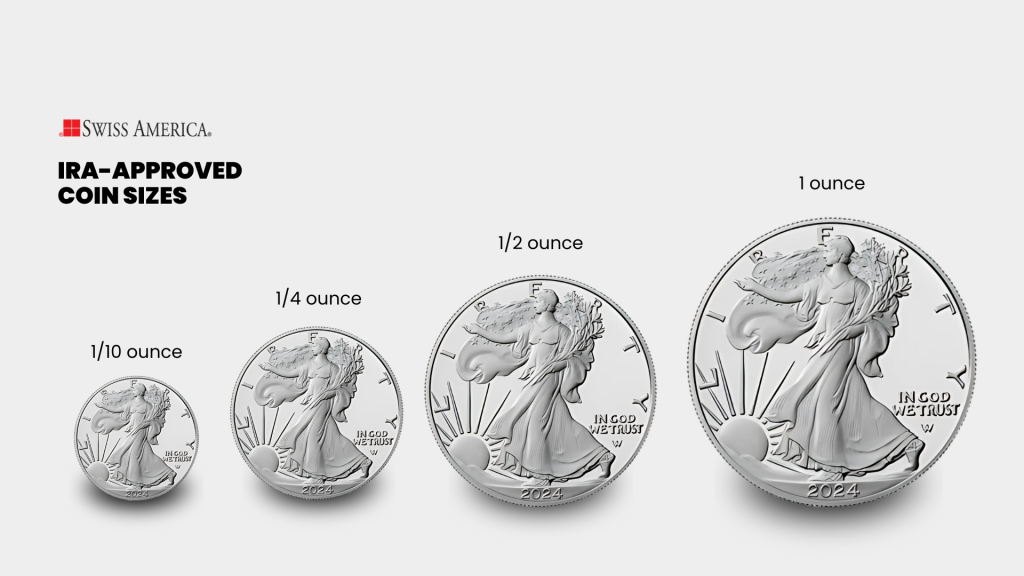
Gold IRA rules and contribution limits
Before you move forward with a gold IRA rollover, make sure you understand the rules and contribution limits. This helps you avoid mistakes that could cost you money in your retirement portfolio.
A Gold IRA has the same rules and regulations as a regular IRA that holds conventional assets, like stocks and bonds. But there are two main rules to consider and follow:
Annual Gold IRA contribution limit
One of the most important IRS rules around a gold IRA rollover is the amount of contributions you can make per year. For Gold IRA investing, account holders can only contribute a limited amount of funds to their IRA account in a year.
The 2025 limits are:
- Under 50 annual contribution limit: $7,000
- 50 and over annual contribution limit: $8,000
Phase-out arrangements
You can contribute up to the annual limit to your gold IRA each year as long as you have enough earned income to support it. Whether or not that contribution is tax-deductible depends on your income and whether you or your spouse has a retirement plan at work. If your income is too high, your deduction might be reduced or even phased out completely. These income limits are known as phase-out ranges.
The limits for 2025 are:
- For single taxpayers with a workplace retirement plan: $79,000–$89,000
- For married couples filing jointly: $126,000–$146,000
- For IRA contributors not covered by a workplace plan, married to a covered spouse: $236,000–$246,000
- For married individuals filing separately with a workplace plan: $0–$10,000.
Overcontributing to your gold or silver IRA account during an IRA rollover results in penalties and taxable events. Gold IRA investors usually have to pay a 6% penalty on their overcontributed portion.
Common fees associated with Gold IRAs
Before you open a precious metals IRA, make sure you understand the fees involved. There are both one-time and ongoing costs you’ll need to consider.
To start, there’s usually a setup fee when you open the account. This can range from $50 to $150, depending on the company. After that, your custodian will charge an annual fee to handle account maintenance and administration. That’s typically somewhere between $50 and $150 a year.
You’ll also have storage fees since the metals need to be kept at a secure third-party depository. Those can range from around $50 up to $300 annually.
The Swiss America team often works with Gold Star Trust. Their published fees are:
- Account setup: $50
- Annual maintenance: $90/year
- Commingled storage: $100/year
The exact fees can vary depending on which gold IRA custodian or company you work with.
Gold IRA Fee Summary
| Fee type | Description |
| Account setup | One-time fee to set your account. |
| Annual maintenance fee | Recurring annual fee for account administration. |
| Segregated storage | Annual fee for storing your metals separately from others. |
| Non-segregated storage | Annual fee for storing your metals with other investors. |
| Buy, sell, exchange | Fee for buying, selling, or exchanging metals within your account. |
| Cashier’s check or wire transfer | Fees for funding logistics. |
| Various other fees like late fees, paper statements, termination fee, etc. | Various fees. |
Gold IRA myths
As a Gold IRA provider, will often the same questions from investors because of myths that are floating around out there so let’s debunk a few of them.
Myth: You can store your gold at home
You can’t store your gold at home. Some people think this is an option, but that’s not how a gold IRA works. There is a complicated process if you try to go that route, but it raises a lot of red flags and opens the door to potential IRS issues. It’s not worth the risk.
Myth: Gold IRAs help you avoid taxes
Setting up a gold IRA doesn’t give you a special tax break. It works the same way as any other IRA. Reducing taxes comes down to planning. That includes when you sell, what your income looks like at the time, and whether you opened a traditional or Roth account. The type of account and the timing matter more than the fact that it holds gold.
Myth: You can’t sell gold
A common misconception is that once you buy gold in your IRA, you’re locked in. That’s not the case. You can sell your gold at any time, and in most situations, you can sell it back to the same dealer you bought it from. While it’s not as instant as selling a stock with the click of a button, it’s still a smooth process when you’re working with a reputable dealer.
If you sell the gold and don’t take a distribution, the proceeds stay inside your IRA. From there, you can move the funds into another investment type like stocks, bonds, or something else allowed within your IRA, without triggering taxes or penalties.
Withdrawals from a Gold IRA
If you decide to purchase gold or other precious metals with retirement savings, you may wonder what happens when you want to withdrawal in the future? IRS rules state that the only distributions allowed from a gold IRA are in cash or physical gold.
When you reach retirement age and want to sell, you’ll contact your Gold IRA custodian and choose a cash distribution or physical distribution:
- Cash distribution: The metals get sold at current market value you you’ll receive the proceeds.
- Physical distribution: The depository ships the metals directly to you.
Choosing a precious metals dealer
When you’re ready to add gold to your investment portfolio, you’ll want to choose the right Gold IRA company. Here are a few things to look for before making your decision:
Experience through different cycles
Look for a company that’s been around long enough to have seen multiple economic cycles. Firms with decades of experience have seen both bull and bear markets and know how to guide investors through all kinds of conditions. Swiss America has been in business for over 40 years, working with investors through every type of market.
Satisfied clients
Reputation matters. A reliable gold IRA company should have a track record of happy clients, timely delivery, and responsive customer service. You want a team that’s easy to reach and knows what they’re talking about whenever you have questions. Curious what it’s like to work with Swiss America? Check out our client reviews.
Knowledgeable guidance
The company should offer more than just transactions. Look for one that can give you expert advice on things like secure storage, gold-to-silver ratios, how metals fit into your broader portfolio, and what trends to keep an eye on. That’s the kind of education Swiss America offers through its blog, podcast, and a wide range of in-depth guides for investors.
Transparent pricing
Pricing should never be a mystery. Leading gold IRA companies offer transparent pricing with upfront fees and no hidden clauses. At Swiss America, our broker team takes the time to explain all pricing details before you make a decision.
Buyback option
Life happens, so having access to liquidity is key. Some companies offer gold trade or buyback programs, which allow you to sell your metals back when you need to. This is especially helpful for rebalancing your portfolio or covering unexpected expenses.
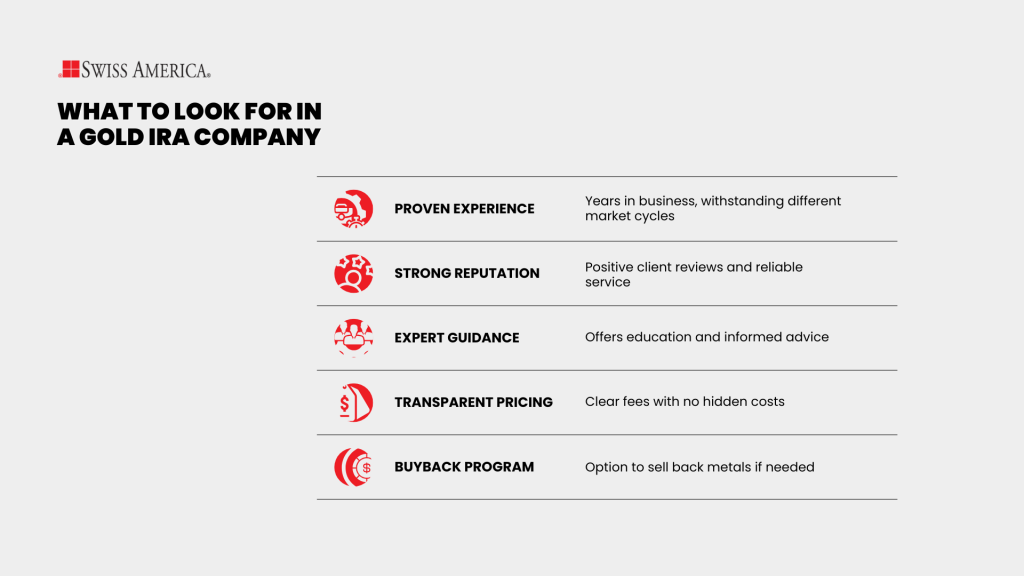
Final thoughts about Gold IRA transfer
Getting started with gold or other precious metals is a straightforward process, especially when you work with a top Gold IRA company to guide you through it. Gold investments bring peace of mind, helps protect a portion of your portfolio, and keeps you prepared for whatever might come next.
No one knows what the future holds with the economy, global conflict, or the next unexpected shock. That’s why so many people use gold and other metals as a safety net.
If you want to learn more about using your retirement funds to invest in precious metals, check out our Free Gold IRA Kit and connect with the Swiss America team today!
Precious metals IRA rollover: FAQs
What are the negatives of a precious metals IRA?
A precious metals IRA comes with storage fees and doesn’t generate income like dividends or interest. It also takes a little more time to buy and sell compared to traditional paper assets.
Can I roll my 401(k) into precious metals?
Yes, you can roll over a 401(k) into a precious metals IRA, but usually only after you’ve left the employer. The process involves setting up a self-directed IRA and working with a custodian to handle the transfer.
How to avoid taxes on precious metals?
To avoid taxes, hold your precious metals inside a self-directed IRA. This keeps any gains tax-deferred until you take distributions in retirement.
The information in this post is for informational purposes only and should not be considered tax or legal advice. Please consult with your own tax professionals before making any decisions or taking action based on this information.
